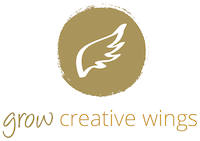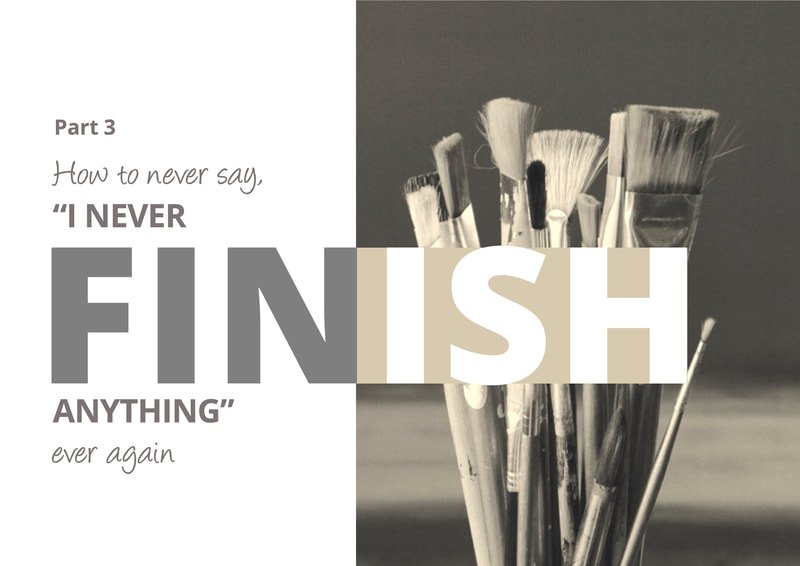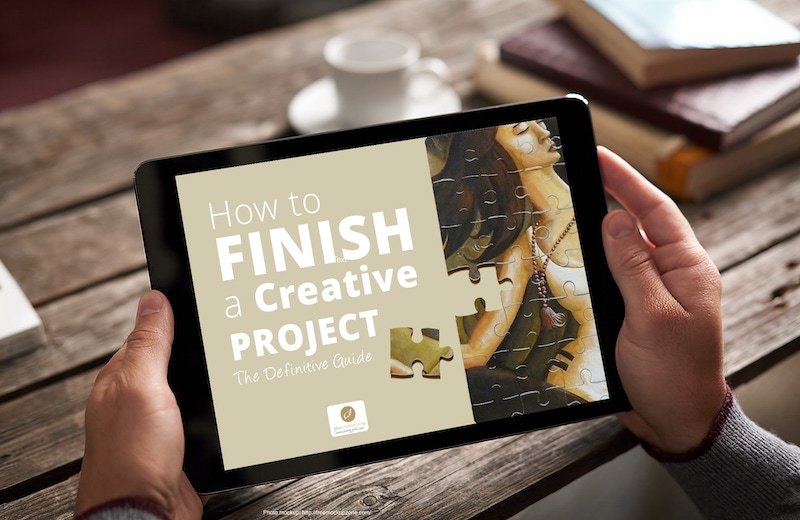The Definitive Guide to
How to Finish a Creative Project
I used to struggle massively with my inability to finish creative projects. I'd start off full of bright-eyed enthusiasm, convinced that this painting or eBook would be the next big thing. The thing that would cement my creative voice and even rocket me into the public eye.
But fast-forward a few days/weeks/months, and the project would be abandoned in a corner gathering dust. Or shoved into a drawer where it didn't shame me with its incompleteness on a daily basis.
I was the most unlikely candidate to become a ‘serial finisher’.
Yet, these days, I finish pretty much all the creative projects I start. (With the one caveat that I can ditch a project if it isn’t serving my goals.)
So how did I turn around my inability to finish projects?
And why is it so important to finish what you started anyway?
Should you finish absolutely everything?
And how can you learn to motivate yourself to finish your creative projects and become the person who never says “I never finish anything”?
All this and more in this definitive guide to the fine art of FINISHING.
Scroll down to keep reading or
Get the Definitive Guide to Finishing eBook
Bumper guide to the fine art of FINISHING!
All three long-form articles combined in one 115 page book (See contents below)
Beautifully laid out in an easy-to-read format
Read offline on any device
CONTENTS
Why It’s Important to Finish What You Started
Artists, indie content creators and creative solopreneurs of all stripes. We have to face finishing projects constantly.
We’re responsible for deciding which projects to undertake, how long to spend on them, and whether they’re done.
(Unless we're doing a commission, client work or have some other deadline, that provides accountability.)
Yet most of us don’t have the tools to manage this crucial part of our work-life effectively. Handing in school projects on time doesn't prepare us for the amorphous life of a self-employed creative.
It’s all too easy to get into a cycle of starting projects, running out of enthusiasm, and setting them aside.
“Everybody starts projects. Successful people finish them.”
Finishing a side project
But what if you’re trying to finish a side project? Something you hope might create an extra revenue stream or pivot you into a new career? It can even harder to find the time, energy and motivation to work on your project. You’ve already given your best of those to your day job!
The good news is, that everything I’m going to tell you about finishing, applies to side projects as well.
No more unfinished art or creative projects
Having lots of unfinished creative projects clearly makes us feel unsatisfied and demoralised.
(I’m sure your inner critic has a field day calling you ugly names when you do this. Mine definitely used to.)
But do you understand exactly why not finishing is such a negative thing in your creative life? Have you considered how much it hampers your creative and professional development? And even, gasp, your development as a person?
Before we look at strategies for finishing our creative projects, let’s begin our journey by taking a look at why it’s so important to finish what we start.
Unlocking the Secret Rewards of Finishing
Years ago I created a series of seven collage paintings based on the story of the Handless Maiden. As I finished each one I would have an illuminating dream about the meaning of the painting.
Here's the thing. If I hadn’t finished the painting, I wouldn’t have got the illumination. And those illuminations were integral in my overcoming years of debilitating creative block.
This was my first lesson on the importance of finishing what I started. It helped me see that finishing a project gives us valuable insights that we need to move onwards and upwards. We unlock secret rewards that it’s impossible for us to get unless we finish!
Finishing: Key to building creative confidence
Being self-confident as artists and creatives is crucial. As it turns out, finishing each piece of work - or series - is one of the most important habits that build confidence.
At the most basic level, it means we start each new piece of work, confident of finishing it even if the going gets rough. We’ve come up against the difficult patches before and come out the other side. This experience teaches us where the pitfalls likely lie so we can develop the strategies necessary to deal with them.
But self-confidence is just the beginning. There are many more benefits to finishing. Benefits which will move our creative work and careers forward.
Review to ramp up your creative development
Achieving closure on a creative project, gives you a compass for how to move forward.
Is this a theme that still needs more exploration? Or a technique you need to refine? Does it suggest a new avenue you hadn't thought of?
When you review your finished work you take the guesswork out of your creative direction. You get all sorts of clues about how you work best, and what you’re interested in - or not.
It helps you set concrete objectives for future work - opening up new directions or consolidating an existing one. And in doing this, you establish a healthy cycle of creative development and growth.
Practical benefits of competing projects
Completing a project makes you push the boundaries of your comfort zone at some point
(Ask yourself, why you’re doing this project if it doesn’t!)
This, in turn forces you to overcome obstacles.
Some of these obstacles will be psychological. How or when you work best, where your sticking points are and what causes you to lose confidence, for example.
But, you’re also likely to face lots of practical ones.
And overcoming practical obstacles is precisely what ramps up your skillset. It makes you better at what you do. Think craftsmanship, professionalism and mastery.
(I learned the hard way about the importance of correct measurements when I start a new artist’s book!)
Why Not Finishing Is Worse Than Not Starting
On the other hand, when we leave projects unfinished, we get into a negative cycle of incompletion that stops us from growing.
We don’t learn the lessons we need from doing the whole process from start to end. We don’t develop our skills and competencies. We don’t get the potentially valuable feedback that sharing our work, or sending it to market, can give.
As a result, we jump from project to project, feeling dissatisfied with both the experience and our inability to complete.
Not finishing is worse than not starting. We spend a bunch of time, effort and emotional energy and we end up with nothing to show for it.
And, counter-intuitively, leaving your projects unfinished actually diminishes the likelihood you'll feel satisfied with your work!
Don’t believe me? Just think of how many times you take out an old piece of work and wonder why you disliked it so much at the time. Time lends perspective. We’re actually more likely to feel at peace with the result of our work when we view it with ‘new eyes’ after an interval.
But only by completing the work do we make that possible.
Should You Finish Everything?
There are definitely a whole host of benefits to finishing your projects. But life is too short to spend working on projects that aren’t serving you.
Stubbornly trying to finish everything, blinds us to whether we’re doing effective work. Or feeling fulfilled by the work we’re doing.
In 2018 I decided to call a halt 6 months into a ‘make something every week’ project. I realised I had achieved my original goal and the project was no longer serving me.
I was able to do this pivot without too much angst because I was clear on the goals of my project. (Yes, I’d written them down and could refer to them!)
So when you’re questioning the validity of finishing, it’s crucial to have reliable criteria on which to base your decision.
(We’ll talk about this later in the section on setting measurable outcomes in Part 2.
Selling work unfinished
Of course, when we’re talking about creative people, there will always be exceptions.
Antonio López García - considered Spain's greatest living realist painter - has an interesting point of view on finishing. And why it might not always be necessary to 'finish' a painting in order to sell it!
But even for a renowned painter like García, there are limits.
According to a tongue-in-cheek Guardian article, in May 2013 García was ordered by the Spanish Department of Heritage to 'stay in the royal palace and complete his portrait of the Spanish royal family'. At that point, the portrait had been in progress for 18 years.
Yes, you read that right, EIGHTEEN years!
And I thought I painted slowly…
For an insight into García's working practice, watch this excerpt from Victor Erice's documentary El Sol del Membrillo. In it, García explains his struggle to portray the sun's rays filtering between the leaves of a quince tree.
Turns out García isn’t alone in his philosophy. Taoist artists saw not finishing their work as part of their spiritual practice.
Decide if it’s an Experiment or a Commitment
One way to decide whether the project we’re undertaking is something it’s important to finish is by differentiating between ‘experiments’ and ‘commitments’.
“Experiments are okay to quit. The goal of the experiment is to not be afraid to try something out, so you want to lower the barriers to getting started. If you later don’t feel like doing it, you can stop, no guilt or stress.
Commitments need to be carried out to the very end…Unless it becomes impossible to finish your commitment, you continue going forward with it.”
By creating these two mental categories, we give ourselves permission to jump right in and start something which it might not be important to finish. But at the same time, it makes us more cautious about entering into commitments without thinking about their implications beforehand.
(Learn how to do this in more detail in The Most Important Thing BEFORE Planning Your Creative Project.
Why We Abandon Projects Mid-Way
When we begin a new project we’re full of enthusiasm for our new idea. It’s a bit like falling in love. We daydream of a rosy future in which we’ve created a spectacular piece of work. Perhaps we even imagine receiving acclaim for our creation. Everything in our creative garden is very, very lovely.
At this point, we don’t think about the many hours of hard work we’ll have to do to complete our project. Or the obstacles and challenges we'll encounter along the way.
But as we get into the project, we leave the novelty period behind and the end point seems very, very far away. The work often feels harder than we imagined and takes longer than we’d hoped.
Sometimes we even get stuck and don’t know why.
We fall into a cycle of putting off working on our project. We hope that one day our enthusiasm will magically reappear and we’ll get back on track.
But the hard truth is that we need to deal with the underlying causes of why we leave projects unfinished. Otherwise we won’t find enthusiasm for our abandoned project again. Or - if we do - it’s liable to be short-lived. And we’ll soon find ourselves abandoning it again.
Build awareness of your pattern of starting and stopping
One of the first questions I ask new clients is,
‘Have you tried to do this - or something similar - before? What problems did you encounter?’
The first step in solving a problem is always recognising that we have one.
When we're aware of our patterns of starting and stopping, we can anticipate the problems before they happen. And be ready with solutions!
In Part 2. How to Overcome Your Ability to Finish Projects, we’ll look in detail at the common reasons we abandon a project part way through. But in the the meantime you can build an awareness of your own patterns by using this exercise.
Instructions for discovering your patterns of starting and stopping
Grab a piece of paper and a pen and write a list of every past project you can remember that you started but didn’t finish.
(Include that Spanish class you signed up for but dropped out of mid-term, the jumper you started knitting only later to leave the wool moulding in your garage, the coffee table out of reclaimed pallets, the novel last Nanowrimo…You get the picture.)
Once you’ve your list, try to remember what got in your way on each occasion.
Maybe the friend you were going to Spanish with moved out of town? Or the knitting pattern was more complex than you imagined. Or maybe you didn’t have the right tools to make the joints for the coffee table? Or the idea you had for your novel didn’t seem to go anywhere.
Do you notice commonalities as to why you stopped?
Now ask yourself, how you might have overcome the obstacles that you faced in each instance. Jot down any solutions that come to mind.
Leave the list somewhere accessible. Additional solutions may come to you later as your subconscious works on the problem.
Great! Now you've acknowledged that you’ve been through multiple cycles of starting and not finishing projects. This means you’re much better placed to ensure the conditions are right for you to finish your next project.
(We’ll be working on this in Part 2.)
Reap the Rewards of Finishing
Finishing a project gives us a feeling of wellbeing in ourselves. We feel confident in our ability to do what we set out to do.
This has a positive knock-on effect to other parts of our life.
We can rely on ourselves. And other people know they can rely on us.
We become people of integrity and professionalism.
With the right state of mind, completing a project can be something to really look forward to. A moment for us to pause and take stock of the journey we made, and to assess future possibilities.
A chance to develop the insight that helps us grow in our craft and flourish in our creative career.
A chance to catch up with other parts of our life's business that easily get neglected when our creative work is all-consuming.
PART 2: This Is How to Overcome Your Inability to Finish Projects
The best moment to develop a strategy to ensure we'll finish, is at the beginning of a project. In Part 2 we’ll be looking at how to do just that.
READ PART 2
OR GET THE EBOOK











